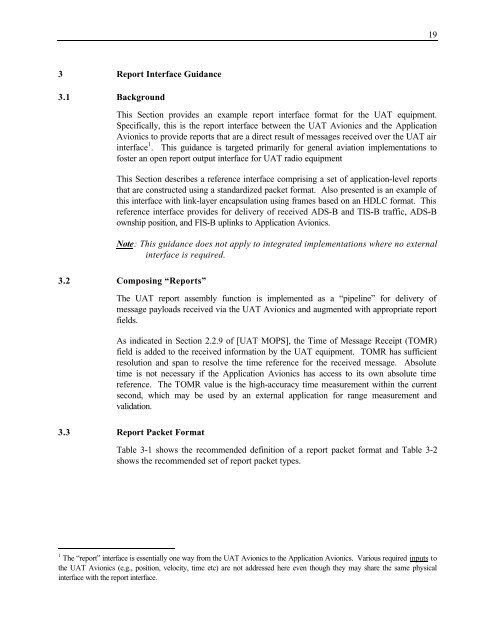Interim Guidance for UAT Avionics Operating with Safe Flight 21 ...
Interim Guidance for UAT Avionics Operating with Safe Flight 21 ...
Interim Guidance for UAT Avionics Operating with Safe Flight 21 ...
Create successful ePaper yourself
Turn your PDF publications into a flip-book with our unique Google optimized e-Paper software.
3 Report Interface <strong>Guidance</strong><br />
3.1 Background<br />
This Section provides an example report interface <strong>for</strong>mat <strong>for</strong> the <strong>UAT</strong> equipment.<br />
Specifically, this is the report interface between the <strong>UAT</strong> <strong>Avionics</strong> and the Application<br />
<strong>Avionics</strong> to provide reports that are a direct result of messages received over the <strong>UAT</strong> air<br />
interface 1 . This guidance is targeted primarily <strong>for</strong> general aviation implementations to<br />
foster an open report output interface <strong>for</strong> <strong>UAT</strong> radio equipment<br />
This Section describes a reference interface comprising a set of application-level reports<br />
that are constructed using a standardized packet <strong>for</strong>mat. Also presented is an example of<br />
this interface <strong>with</strong> link-layer encapsulation using frames based on an HDLC <strong>for</strong>mat. This<br />
reference interface provides <strong>for</strong> delivery of received ADS-B and TIS-B traffic, ADS-B<br />
ownship position, and FIS-B uplinks to Application <strong>Avionics</strong>.<br />
Note: This guidance does not apply to integrated implementations where no external<br />
interface is required.<br />
3.2 Composing “Reports”<br />
The <strong>UAT</strong> report assembly function is implemented as a “pipeline” <strong>for</strong> delivery of<br />
message payloads received via the <strong>UAT</strong> <strong>Avionics</strong> and augmented <strong>with</strong> appropriate report<br />
fields.<br />
As indicated in Section 2.2.9 of [<strong>UAT</strong> MOPS], the Time of Message Receipt (TOMR)<br />
field is added to the received in<strong>for</strong>mation by the <strong>UAT</strong> equipment. TOMR has sufficient<br />
resolution and span to resolve the time reference <strong>for</strong> the received message. Absolute<br />
time is not necessary if the Application <strong>Avionics</strong> has access to its own absolute time<br />
reference. The TOMR value is the high-accuracy time measurement <strong>with</strong>in the current<br />
second, which may be used by an external application <strong>for</strong> range measurement and<br />
validation.<br />
3.3 Report Packet Format<br />
Table 3-1 shows the recommended definition of a report packet <strong>for</strong>mat and Table 3-2<br />
shows the recommended set of report packet types.<br />
1 The “report” interface is essentially one way from the <strong>UAT</strong> <strong>Avionics</strong> to the Application <strong>Avionics</strong>. Various required inputs to<br />
the <strong>UAT</strong> <strong>Avionics</strong> (e.g., position, velocity, time etc) are not addressed here even though they may share the same physical<br />
interface <strong>with</strong> the report interface.<br />
19
















